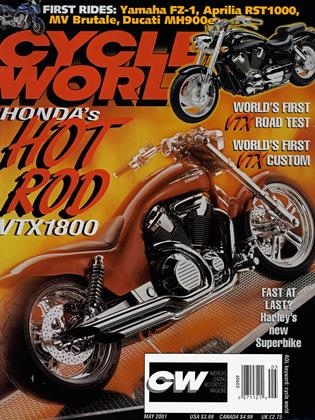HONDA'S FOUR-STROKE FUTURE
ROUNDUP
THIS IS HONDA'S NEW Grand Prix roadracing engine, the V-Five RC211V. Designed to suit the FIM's generous 2002 offer of 990cc for four-stroke GP engines, this is the first of the projected next generation of engines to see the light of day. The mature twostroke racers, now at the 180200 horsepower level, will continue to race in the class at 500cc. The last four-stroke to run in the GPs, Honda's ovalpiston 130-plus-bhp NR500, was overly complex and unable to make the pace. It was withdrawn after 1981. The
RC21IV has three cylinders in its forward bank and two in the rear. The five metal bellmouths of the butterfly-throttled PGM fuel-injection bodies can be seen in the Vee. There are no “showerhead” top injectors, as used on the V-Four RC45. The four cams are driven by 10 gears on the right side, above the primary drive to the dry clutch. The cases are horizontally split with integral cylinders and a deep wet sump. The press release tells us the cylinders are round, each with four valves. The central sparkplug above each cylinder suggests the combustion chambers are conventional. B Honda says the central points of p the 21 lV’s K design are mass een1 tralization | and low frontal area-it is only three cylinders wide. The
The photo asks more than it tells. Does the RC211V have pneumatic valve closers instea of traditional metal springs? Pneumatic-valve engines look
like conventional buckettappet-over-spring engines, so we don’t know. Honda’s Yasu Ikenoya has asserted that the company’s four-stroke would be conventionally field-serviceable, which might exclude pneumatics. How
do you balance a VFive? An inline-Six is made up of two inline-Triples mated end-to-end. Despite the vigorous rocking couples of each Triple (wobble, or kayakpaddle motion), the Six is smooth; the two rocking couples cancel. In an inline-Five, there is no vertical shaking force but a rocking couple remains. Some have proposed that the 21 lV’s pistons must be of different sizes and weights in the two banks, but there may be an easier way. Honda
never uses more bearings if fewer will do. This means no more than three crankpins and four main bearings. Think of the outer four cylinders (excluding the center one in the front bank) as being a V-Four with a 360-degree crank, much like the RC45. If the,Vee angle is less than 90 degrees (90 gives minimum vertical shaking force), ILLUSTRATION some vertical shaking is created but with no side-to-side rocking couple. If the front center cylinder’s vertical shaking force is opposed to this, the two may to a degree cancel. This would leave small residual shaking to be countered by a simple balancer, possibly on an idle shaft in the Vee.
Another small point: Note the black rubber vibration dampers on the exhaust-pipe springs. The lack of these on the factory RC51s at last year’s Daytona 200 caused several spring breakages. Details count!
Horsepower? Let’s model it two ways, one with a Superbike-like 1.6:1 bore-to-stroke ratio and one with a radical, Formula One-style 2.25:1. The first case gives us a 46mm stroke, the second 37mm, and safe peak revs of maybe 15,000 and 18,500, respectively. Using a likely stroke-averaged combustion pressure and these revs gives estimates of 217 and 260 bhp. Now, find a tire to handle bhp. that power.
Kevin Cameron















